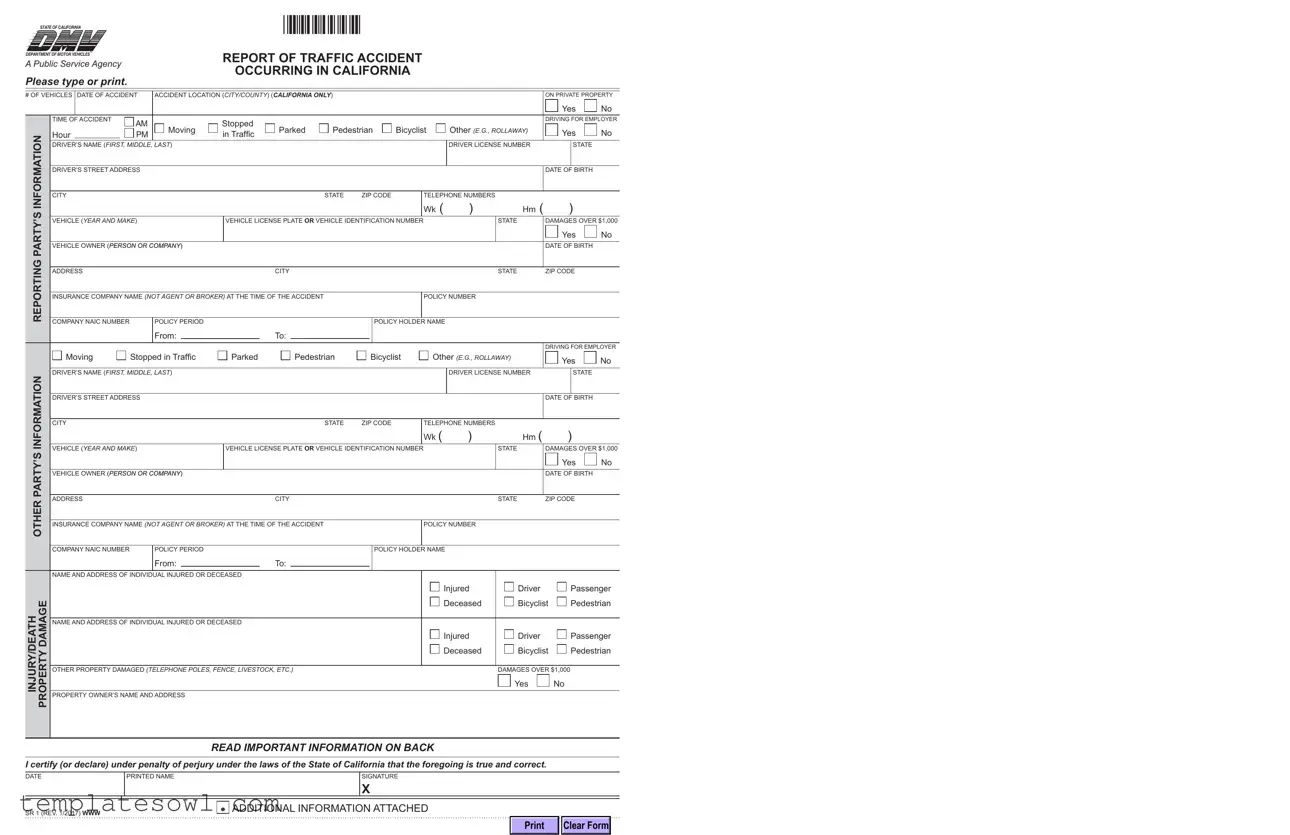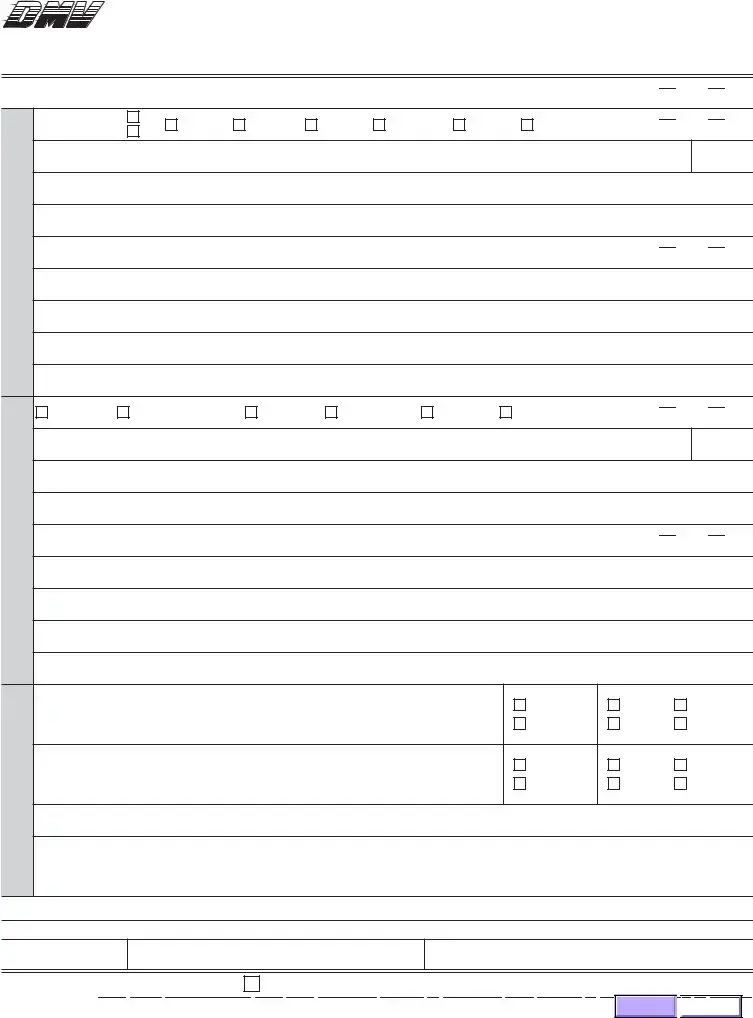STATE OF CALIFORNIA
DEPARTMENT OF MOTOR VEHICLES®
A Public Service Agency
Please type or print.
*SR1*
REPORT OF TRAFFIC ACCIDENT
OCCURRING IN CALIFORNIA
# OF VEHICLES |
DATE OF ACCIDENT |
ACCIDENT LOCATION (CITY/COUNTY) (CALIFORNIA ONLY) |
|
|
|
|
|
|
|
|
|
|
|
|
|
|
|
|
|
|
|
|
|
|
|
|
|
|
|
|
|
|
|
|
TIME OF ACCIDENT |
AM |
|
|
Stopped |
|
|
|
|
|
|
|
|
|
|
|
|
|
|
|
|
|
Moving |
Parked |
Pedestrian |
Bicyclist |
Other (E.G., ROLLAWAY) |
INFORMATION |
Hour |
|
|
PM |
in Traffic |
|
|
|
|
|
|
|
|
|
|
|
|
|
|
|
|
|
|
|
|
|
|
|
|
|
|
|
|
|
|
|
|
|
DRIVER’S NAME (FIRST, MIDDLE, LAST) |
|
|
|
|
|
|
|
|
|
|
|
|
DRIVER LICENSE NUMBER |
|
|
|
|
|
|
|
|
|
|
|
|
|
|
DRIVER’S STREET ADDRESS |
|
|
|
|
|
|
|
|
|
|
|
|
|
|
|
|
|
|
|
|
|
|
|
|
|
|
|
|
|
|
|
|
|
|
|
|
CITY |
|
|
|
|
|
|
|
|
STATE |
ZIP CODE |
|
TELEPHONE NUMBERS |
|
|
|
|
|
|
|
|
|
|
|
|
PARTY’S |
|
|
|
|
|
|
|
|
|
|
|
|
|
|
|
|
|
Wk ( |
) |
|
Hm ( |
|
|
|
|
|
|
|
|
|
|
|
|
|
|
|
|
|
|
|
|
|
VEHICLE (YEAR AND MAKE) |
|
|
|
VEHICLE LICENSE PLATE OR VEHICLE IDENTIFICATION NUMBER |
|
|
STATE |
|
|
|
|
|
|
|
|
|
VEHICLE OWNER (PERSON OR COMPANY) |
|
|
|
|
|
|
|
|
|
|
|
|
|
|
|
|
|
|
|
|
|
|
|
|
|
|
|
|
|
|
|
REPORTING |
ADDRESS |
|
|
|
|
|
CITY |
|
|
|
|
|
|
|
|
STATE |
|
|
|
|
|
|
|
|
|
|
|
|
|
|
|
|
|
|
|
|
|
|
|
|
|
|
|
|
|
|
|
INSURANCE COMPANY NAME (NOT AGENT OR BROKER) AT THE TIME OF THE ACCIDENT |
|
|
|
|
|
|
POLICY NUMBER |
|
|
|
|
|
|
|
|
|
|
COMPANY NAIC NUMBER |
|
POLICY PERIOD |
|
|
|
|
|
|
|
|
|
|
|
|
|
|
|
|
|
|
|
|
|
|
|
|
|
POLICY HOLDER NAME |
|
|
|
|
|
|
|
|
From: |
|
|
|
To: |
|
|
|
|
|
|
|
|
|
|
|
|
|
|
|
|
|
|
|
|
|
|
|
|
|
|
|
|
|
|
Moving |
Stopped in Traffic |
|
Parked |
|
|
Pedestrian |
|
Bicyclist |
Other (E.G., ROLLAWAY) |
|
|
DRIVER’S NAME (FIRST, MIDDLE, LAST) |
|
|
|
|
|
|
|
|
|
|
|
|
|
INFORMATION |
|
|
|
|
|
|
|
|
|
|
|
|
DRIVER LICENSE NUMBER |
DRIVER’S STREET ADDRESS |
|
|
|
|
|
|
|
|
|
|
|
|
|
|
|
|
|
|
|
|
|
|
|
|
|
|
|
|
|
|
|
|
|
|
|
|
|
|
|
|
|
|
|
|
|
|
|
|
|
|
|
|
|
|
|
|
|
|
|
|
|
|
|
|
|
|
|
|
|
|
|
CITY |
|
|
|
|
|
|
|
|
STATE |
ZIP CODE |
|
TELEPHONE NUMBERS |
|
|
|
|
|
|
|
|
|
|
|
|
|
|
|
|
|
|
|
Wk ( |
) |
|
Hm ( |
PARTY’S |
VEHICLE (YEAR AND MAKE) |
|
|
|
VEHICLE LICENSE PLATE OR VEHICLE IDENTIFICATION NUMBER |
|
|
STATE |
|
VEHICLE OWNER (PERSON OR COMPANY) |
|
|
|
|
|
|
|
|
|
|
|
|
|
|
|
|
|
|
|
|
|
|
|
|
|
|
|
|
|
|
|
|
|
|
|
|
|
|
|
|
|
|
|
|
|
|
OTHER |
ADDRESS |
|
|
|
|
|
CITY |
|
|
|
|
|
|
|
|
STATE |
|
|
|
|
|
|
|
|
|
|
|
|
|
|
|
INSURANCE COMPANY NAME (NOT AGENT OR BROKER) AT THE TIME OF THE ACCIDENT |
|
|
|
|
|
|
POLICY NUMBER |
|
|
|
|
|
|
|
|
|
|
|
|
|
|
|
|
|
COMPANY NAIC NUMBER |
|
POLICY PERIOD |
|
|
|
|
|
|
|
|
|
|
|
|
|
|
|
|
|
|
|
|
|
|
|
|
|
POLICY HOLDER NAME |
|
|
|
|
|
|
|
|
From: |
|
|
|
To: |
|
|
|
|
|
|
|
|
|
|
|
|
|
|
|
|
|
|
|
|
|
|
|
|
|
|
|
|
|
|
|
NAME AND ADDRESS OF INDIVIDUAL INJURED OR DECEASED |
|
|
|
|
|
|
|
|
|
|
|
|
|
ON PRIVATE PROPERTY

 Yes
Yes  No
No
DRIVING FOR EMPLOYER

 Yes
Yes 
 No
No
STATE
DATE OF BIRTH
)
DAMAGES OVER $1,000

 Yes
Yes 
 No
No
DATE OF BIRTH
ZIP CODE
DRIVING FOR EMPLOYER

 Yes
Yes 
 No
No
STATE
DATE OF BIRTH
)
DAMAGES OVER $1,000

 Yes
Yes 
 No
No
DATE OF BIRTH
ZIP CODE
INJURY/DEATH PROPERTY DAMAGE
NAME AND ADDRESS OF INDIVIDUAL INJURED OR DECEASED
OTHER PROPERTY DAMAGED (TELEPHONE POLES, FENCE, LIVESTOCK, ETC.)
PROPERTY OWNER’S NAME AND ADDRESS
Injured |
|
Driver |
Passenger |
Deceased |
|
Bicyclist |
Pedestrian |
Injured |
|
Driver |
Passenger |
Deceased |
|
Bicyclist |
Pedestrian |
|
DAMAGES OVER $1,000 |
|
|
Yes |
|
No |
READ IMPORTANT INFORMATION ON BACK
I certify (or declare) under penalty of perjury under the laws of the State of California that the foregoing is true and correct.
ADDITIONAL INFORMATION ATTACHED

 Clear Form
Clear Form

A |
YOUR |
CALIFORNIA INSURANCE INFORMATION |
|
DO NOT DETACH |
DMV FILE NUMBER |
The Department may send this part to the insurance company indicated. If not fully completed, |
|
|
VEHICLE |
|
|
it will be assumed you were not insured for the accident and your license will be suspended. |
|
|
|
|
|
|
|
|
|
|
|
|
NAME OF INSURANCE COMPANY (NOT AGENT OR |
|
|
|
|
|
|
BROKER) THAT ISSUED THE LIABILITY POLICY |
|
|
|
|
|
|
COVERING THE OPERATION OF YOUR VEHICLE |
|
|
|
|
|
|
POLICY NUMBER |
|
POLICY PERIOD |
|
|
|
|
|
|
|
|
|
From: |
To: |
|
|
I |
|
|
|
DRIVER LICENSE NUMBER |
|
|
|
|
|
|
|
|
|
|
(DRIVER OF YOUR VEHICLE) |
N |
DATE OF ACCIDENT |
IN OR NEAR (CITY OR TOWN) (CALIFORNIA ONLY) |
|
|
|
|
|
S |
|
|
|
|
|
|
|
|
|
|
|
|
U |
|
|
|
|
|
|
|
|
|
|
|
VEHICLE (YEAR AND MAKE) |
|
VEHICLE IDENTIFICATION NUMBER |
|
|
|
VEHICLE LICENSE PLATE NUMBER |
STATE |
R |
|
|
|
|
|
|
|
|
|
|
|
|
A |
|
|
|
|
|
|
|
|
|
|
|
|
N |
DRIVER |
|
|
|
|
ADDRESS |
|
|
|
|
|
C |
|
|
|
|
|
|
|
|
|
|
|
|
E |
|
|
|
|
|
|
|
|
|
|
|
|
OWNER |
|
|
|
|
ADDRESS |
|
|
|
|
|
|
|
|
|
|
|
|
|
|
|
|
|
|
FULL NAME OF POLICY HOLDER |
|
|
|
ADDRESS |
|
|
|
|
|
|
|
|
|
|
|
|
|
|
|
|
|
|
|
|
|
|
|
|
|
|
|
|
|
|
|
SR 1A (REV. 1/2017) WWW
If the policy was not in effect, this form must be completed and returned to DMV within 20 days.
The undersigned company advises that with respect to the reported accident, the policy reported on the reverse side:
WAS NOT IN EFFECT |
|
|
|
|
|
|
|
Was not a liability policy |
Did not cover the vehicle/driver |
Number is not a company policy number |
Policy Number |
|
|
|
Policy Period from |
|
to |
|
Signature |
|
|
|
|
MAIL TO: |
|
|
|
|
|
|
|
|
Title |
|
|
|
|
|
|
Department of Motor Vehicles |
|
|
|
|
P.O. Box 942884 |
|
|
|
|
|
|
|
|
Sacramento, CA 94284-0884
SR 1A (REV. 1/2017) WWW
IMPORTANT INFORMATION
California law requires traffic accidents on a California street/highway or private property to be reported to the Department of Motor Vehicles (DMV) within 10 days if there was an injury, death or property damage in excess of $1,000. Untimely reporting could result in DMV suspending a driver license. Accidents involving vehicles not required to be registered such as an off-road vehicle (OHV), implement of husbandry, or snowmobile or occurring on a military base or occurring on the driver’s own property involving only the personal property of the driver and there was no injury or death are not reportable.
The law requires the driver to file this SR 1 form with DMV regardless of fault. This report must be made in addition to any other report filed with a law enforcement agency, insurance company, or the California Highway Patrol (CHP) as their reports do not satisfy the filing requirement. An insurance agent, attorney, or other designated representative may file the report for the driver.
The law requires every driver and every owner of a motor vehicle to be “financially responsible” for any injury or damage resulting from operating or owning a motor vehicle. The minimum insurance level for “financial responsibility” is public liability and property damage coverage of $15,000 for injury or death of one person, $30,000 for injury or death of two or more persons and $5,000 property damage per accident. Comprehensive and collision insurance does not meet the legal requirement.
The California Vehicle Code (CVC) §1806 requires DMV to record accident information regardless of fault when individuals report accidents under the Financial Responsibility Law or if law enforcement agencies or CHP investigate and make a report.
WHEN COMPLETING THIS FORM...
Please print within the spaces and boxes on this form. If you need to provide additional information on a separate piece of paper(s) or you include a copy of any law enforcement agency report, please check the box to indicate ‘Additional Information Attached’. If you are the passenger reporting the accident, be sure to identify yourself by using the ‘other’ box and stating ‘passenger’ in the explanation.
•Write unk (for unknown) or none in any space or box when you do not have information on the other party involved.
•Give insurance information that is complete and which correctly and fully identifies the company that issued the policy.
•Place the correct National Association of Insurance Commissioners (NAIC) number for your insurance company in the boxes provided. The NAIC number should be located on your insurance ID card or you can contact your insurance agent or company for the information.
•Identify any person involved in the accident (driver, passenger, bicyclist, pedestrian, etc.) who you saw was injured or complained of bodily injury or know to be deceased.
•Record in the OTHER PROPERTY DAMAGED section any damage to telephone poles, fences, street signs, guard posts, trees, livestock, dogs, etc., meeting the filing requirement, including amount. This may require that you contact the owner of the property for an estimate of damages.
•Once you have completed this report, please mail it to:
Department of Motor Vehicles
Financial Responsibility
Mail Station J237
P.O. Box 942884
Sacramento, CA 94284-0884
DMV does not accept reports or take actions against non-reporting or uninsured motorists unless this SR 1 form is sent to DMV by someone involved in the accident or their designee and the report is received by DMV within one calendar year of the accident date.
ADVISORY STATEMENT
The accident information on the SR 1 is required under the authority of Divisions 6 and 7 of the CVC. Failure to provide the information will result in suspension of the driving privilege. Except as made confidential by law (e.g., medical information) or exempted under the Public Records Act, the information is a public record, is regularly used by law enforcement agencies and insurance companies, and is open to public inspection. CVC §16005 limits the public record for SR 1 reports to accident involvement, but does allow persons with a proper interest (involved drivers, their employers, etc.) to receive specified information. Individuals may inspect or obtain copies of information contained in their records during regular office hours. The Financial Responsibility Unit Manager, 2570 24th Street, Sacramento, CA 95818 (telephone number: 916-657-6677) is responsible for maintaining this information.
SR 1 (REV. 1/2017) WWW



 Yes
Yes  No
No
 Yes
Yes 
 No
No
 Yes
Yes 
 No
No
 Yes
Yes 
 No
No
 Yes
Yes 
 No
No
 Clear Form
Clear Form